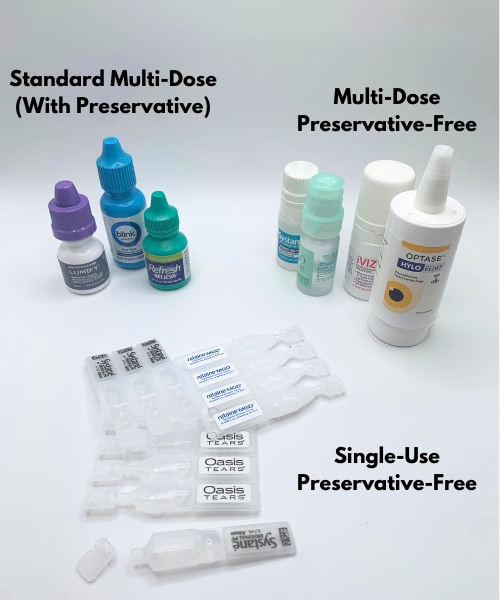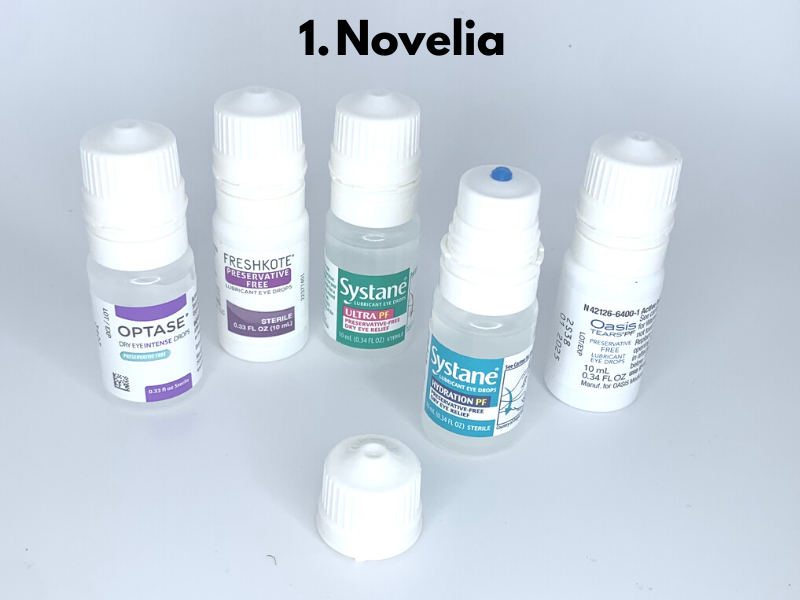Eye Drop Packaging Preferences (9-10/2023)Updated 2 years ago
Dates: 9/26/23 to 10/13/23
Participants: 76
Intro
This survey is about the three different ways over-the-counter eye drops are packaged, and what your experiences and preferences are with each. While there were only 76 participants, I felt the responses were important - not just the data but the comments, which were extremely helpful for understanding some of the current eye drop user trends. I’m planning to do some follow-ups, including to gather everyone’s best tips and suggestions for using over-the-counter drops.

QUESTION 1: How often do you use over-the-counter eye drops in the following packaging:
QUESTION 2: Which factors affect your choice of OTC eye drop packaging?
Trends
Following are some trends gleaned from the many comments on the survey.
1. There's a learning curve.
Many people expressed frustration with the drops dispensing slowly (or too much if they squeezed too hard) and with the residue left in the bottle - both points that are related to understanding how the bottles work.
2. Are MDPF bottles user-friendly? Opinions are split.
Some people find the Aptar and Novelia bottles hard to use:
- "MDPF bottles are too hard to squeeze for us old people. And then you get more drops than you want and waste a bunch."
- "Learning curve was short, however getting the bottle open on subsequent occasions is very difficult I have arthritis and my grip sucks "
- "Hard to express the bottle. I have arthritis."
- "Neurological issues with my hands makes accuracy with multidose bottles almost impossible"
- "Have arthritis in hands, so bottles too difficult to use."
- "Don’t like the MDPF bottles at all. Hard to control amount coming out and the bottles don’t work with the method I use to administer drops."
The Ivizia bottle is definitely popular:
- "I use Ivizia and like the product and dispenser. I also use Refresh Mega 3 which only comes in single use vials- wish it came in a mdpf bottle."
- "Ivizia has the best bottle although I wish it were smaller"
- "I also use Ivizia eye drops for dry eyes whenever I need to. That bottle is very easy to use. I buy the smallest bottle because it has a 90-day shelf life once opened."
And at least one participant appreciates the controlled pump action of the Comod bottle (scroll down for pictures) which is commonly used in Europe but only available for one product in the US at present:
- "My favorite drop is Optase Hylo Relief, mostly because of the dispenser. I love having one drop land at a time."
How about MDPF bottles versus vials? According to the comments, some people prefer vials because they keep drops in multiple locations, which is not practical with bottles that must be discarded within 90 days of opening; some use MDPF bottles at home and vials on the go; and some feel that using MDPF bottles is more economical while others felt it comes out about the same.
By the way, many people complained that MDPF bottles are hard to use when the bottle is nearly empty. For the Aptar and Novelia bottles (the commonest ones in the US) this is actually by design and relates to the filtration mechanisms. The bottles are intentionally over-filled (i.e. contain more than the 10mL on the label) to compensate. If you try to drain every drop, yes, you will probably get frustrated. From the comments, clearly some know this and have learned through experience how to optimize use of the bottles.
3. Many of you would like thicker drops in MDPF bottles.
Celluvisc, in particular, seems to be on many people’s wishlist for the higher tech bottles. (A couple people also mentioned Refresh Mega 3.) Unfortunately, that’s probably not achievable, because thick drops cannot effectively squeeze out through the filtration systems required to keep MDPF bottles from getting contaminated during use.
4. More education is needed on Frankenstein bottles.
It was clear from some of the comments that there is a real need for more safety education about preservative-free eye drops. There is an essential difference between a multi-dose bottle and a muti-dose preservative-free ("MDPF") bottle.
Examples:
- One user mentioned using both OcluMed and Ivizia, but did not seem to understand that while both are preservative-free, only one (Ivizia) is packaged in a bottle that is safe for preservative-free eye drops. (I also need to mention that the makers of OcluMed were the recipient of a Warning Letter from the FDA recently. Click here for more information.)
- Another user referred to Purilens (a preservative-free saline popular amongst scleral lens users) as an “MDPF” type of drop. It actually isn’t - but it made me realize that the terminology may actually not be clear enough. Yes, Purilens is preservative-free; yes, it’s packaged in a multi-dose bottle. But an MDPF bottle is a bottle DESIGNED for preservative-free eye drops - that is, it is a one-way-flow bottle. You can squeeze out, but you can’t suck back in - it has
So here are some user-friendly resources to better understand the issues, both from nonprofit Dry Eye Foundation:
1. DATABASE "Are my eye drops safe?" Easy look-up tool to get details on any OTC eye drop.
2. INFOGRAPHIC (click to download PDF) about selecting eye drops with safe packaging.
3. VIDEO: Preservative-Free Eye Drops: How to Reduce the Risk of Bacterial Contamination.
Dr. Sandra Brown demonstrates how eye drops get contaminated, why special packaging is needed for preservative-free eye drops, and what Frankeinstein eye drops are. (Note: This video was recorded last year, many months before the artificial tear tragedies that made news in 2023.)
More participant comments
- "I'd love to pool everyone's tips and tricks for using MDPF bottles — maybe some of my issues with them have been resolved by the ingenuity of others!" [Great idea - I will run another survey before the end of the year to collect tips!]
- "I've never purchased the single dose packaged drops as they seemed wasteful to me and expensive."
- "I LOVE the MDPF bottles for eye drops put directly in my eye, but I hate them for filling scleral lenses. I'm new (since June) to scleral lenses. I've been using preservative free lubricant drops as my primary fill for the lenses as my eyes adjust and because my eyes are so dry and I find it really, really, difficult to get enough liquid out of the MDPF bottles before the air squeezes out of the bottle and the bottle stops dispensing. I think I would need to very gently and slowly squeeze one drop at a time to make the MDPF bottles work to fill the lenses and that is just not efficient when filling a scleral lens. [Correct, has to be pressed slowly to work well.] So I've gone back to the PF vials, which feels very wasteful and more expensive. I'm hoping to eventually transition to saline for filling, but right now my eyes need the extra lubrication."
- "I wish more options would come in PF packaging. I find the single vials generally easier to use with my troublesome hands than the MD bottles, however I also wish all single vials came with a cap that can be placed back on. Also some of the vials are harder to squeeze than others, same with the bottles. I wish there was more consistency or at least some way to know beforehand. I mainly use Systane Hydration PF in an MDPF bottle. I find their bottles relatively easy to use, but I feel like a substantial amount of the contents is wasted. First, it's more likely I'll dispense an extra drop accidentally. Second, I usually have to shake off at least a small drop after every use. And third, a small amount of product is sometimes left in the bottle once it no longer dispenses (though sometimes storing it upside down will help me get that out). [See note above about the intentional excess.] Occasionally I'll "ruin" a bottle by accidentally squeezing the air out of it, and that is incredibly frustrating. I still vastly prefer this packaging to single-use vials, but I feel like the packaging most brands are using in the US could be improved. [I agree about improvements needed! Interestingly, the Comod bottle is more widely used in Europe, and I wonder whether we'll see that more in the US eventually too.]
- "My doc only lets me use PF drops. I have RCE. I find the vials handy to have in a pocket while walking, and when traveling! I usually use the bottle of PF drops, because I'm sure it's better for the environment. I've only had 1 clog up in 4 years. I like them! My doc also has blood drawn, and spins it into drops for me to keep in my fridge. Those are the MOST SOOTHING EVER, even though it sounds TOTALLY GROSS!"
- "I found the bottle for Systane PF multi-dose difficult to use. [I would love to know which Systane you're referring to. This brand has 3 different drops in the Novelia MDPF bottle.] It's tough to squeeze out and then too much pours out. [It's all about the slow squeeze. You might try Systane Hydration if you haven't already. That's my favorite "nightstand" eye drop, but it definitely took practice to make it work well for me too without getting too much.] I don't like the packaging with the blue rounded top. I used Ivizia multi-dose for a few months and felt it was refreshing at first, like washing water in your eyes, however it was not long lasting relief for DES and I needed to continually use the drops. The most relief and lasting relief i have found has been from the Systane PF vials."
- "So ease-of-use is important to me; hence, I'm a somewhat unhappy drop user when I get to the last half (or so) of my Optase MGD drops. I've had one bottle where I've had no trouble, two bottles where I was squeezing the bottle until the two sides met and no drops came out (I, brace yourself, cut those bottles open and transferred the drops to another bottle that I then stored in the fridge between uses), [YEAH that's a bit terrifying from a contamination standpoint] and one bottle that was sort of in between ease-of-use-wise."
FOR REFERENCE:
Preservative-free multi-dose bottles


